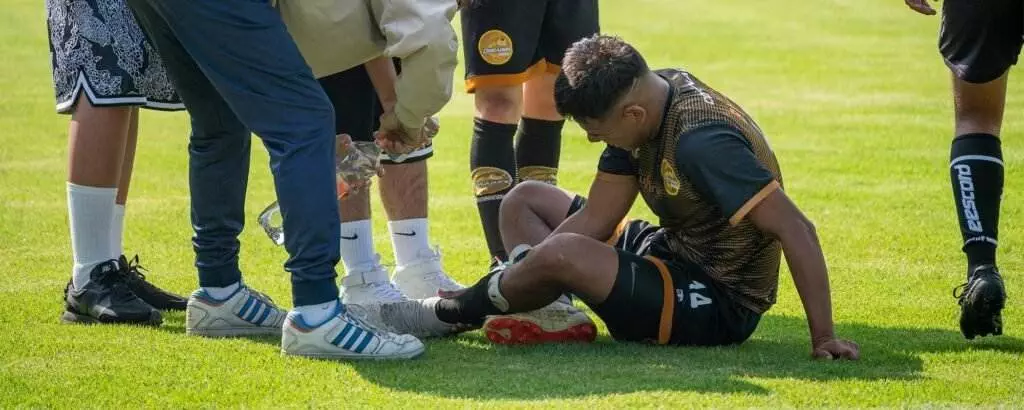At Cochrane Wolves FC, the health and safety of our players are of utmost importance. Soccer, while an exhilarating and physically demanding sport, can sometimes lead to injuries. Understanding how to prevent and manage these injuries is crucial for ensuring that our athletes can enjoy the game while minimizing their risk of harm. In this blog post, we’ll explore common soccer injuries, effective prevention strategies, and the best treatment and recovery options available.
Common Soccer Injuries
1. Sprains and Strains
- Sprains occur when ligaments, the tough bands connecting bones at joints, are stretched or torn. Ankle sprains are particularly common in soccer.
- Strains involve the stretching or tearing of muscles or tendons. Hamstring strains are frequent among soccer players due to the sport’s sprinting demands.
2. Knee Injuries
- Anterior Cruciate Ligament (ACL) Injuries: The ACL is crucial for knee stability. ACL tears are severe injuries often caused by sudden stops, pivots, or awkward landings.
- Meniscus Tears: The meniscus is cartilage that cushions the knee joint. Tears can occur due to twisting motions, often in conjunction with other knee injuries.
3. Shin Splints
- Shin Splints: Pain along the shin bone (tibia) is common among soccer players, especially those increasing their training intensity. It’s typically caused by overuse and stress on the shinbone and surrounding tissues.
4. Fractures
- Fractures: These can occur from direct impacts, such as collisions with other players or falls. Common fracture sites include the toes, feet, and lower legs.
5. Concussions
- Concussions: Head injuries can occur from collisions, falls, or being struck by the ball. Concussions require immediate attention and careful management.
Injury Prevention Strategies
Preventing injuries is always better than treating them. Here are some key strategies we emphasize at Cochrane Wolves FC to keep our players safe:
1. Proper Warm-Up and Cool-Down
A thorough warm-up prepares the body for the demands of soccer, increasing blood flow to muscles and enhancing flexibility. A proper cool-down helps to gradually lower heart rates and stretch muscles, aiding in recovery and reducing stiffness.
2. Strength and Conditioning
Building strength, particularly in the core and lower body, helps support joints and reduce the risk of injury. Conditioning exercises improve overall fitness, making players less susceptible to fatigue-related injuries.
3. Technique and Training
Teaching proper techniques for movements such as jumping, landing, and cutting can help prevent injuries. Drills that focus on balance, agility, and coordination are also beneficial.
4. Hydration and Nutrition
Adequate hydration and proper nutrition are essential for maintaining peak physical condition. Dehydration and poor nutrition can lead to fatigue, which increases injury risk.
5. Appropriate Footwear
Wearing the right soccer cleats for the playing surface can prevent slips, falls, and other injuries. Properly fitting shoes also reduce the risk of blisters and foot injuries.
6. Rest and Recovery
Ensuring players get adequate rest between training sessions and games is vital. Overtraining can lead to fatigue and increase the risk of overuse injuries.
Injury Management and Treatment
Despite best efforts, injuries can still occur. Knowing how to manage and treat them effectively is crucial for a swift and safe recovery.
1. Immediate Response to Injury
- R.I.C.E Method: For acute injuries like sprains and strains, the Rest, Ice, Compression, and Elevation method can help reduce swelling and pain.
- Medical Attention: Seek professional medical advice for severe injuries, such as fractures or suspected concussions.
2. Professional Treatment Options
- Physical Therapy: A physical therapist can design a rehabilitation program tailored to the specific injury, helping to restore strength, flexibility, and function.
- Medication: Over-the-counter pain relievers and anti-inflammatory medications can help manage pain and swelling. Always consult with a healthcare provider before starting any medication.
- Surgery: In severe cases, such as major ligament tears or fractures, surgery may be necessary to repair the damage. Post-surgical rehabilitation is crucial for full recovery.
3. Rehabilitation and Recovery
- Gradual Return to Activity: Following an injury, players should gradually return to their regular training routine, ensuring that the injured area has fully healed and regained strength.
- Strengthening Exercises: Specific exercises to strengthen the injured area can prevent recurrence and improve overall stability.
- Monitoring Progress: Regular check-ins with healthcare providers or physical therapists can help track recovery progress and adjust rehabilitation plans as needed.
4. Preventing Re-Injury
- Follow Rehab Plans: Adhering strictly to rehabilitation plans and not rushing the return to full activity can prevent re-injury.
- Continuous Conditioning: Ongoing strength and conditioning exercises can help maintain the physical fitness required to prevent injuries.
Supporting Your Young Athlete
As parents and guardians, you play a crucial role in supporting your young athlete’s health and well-being. Here are some tips to help:
- Encourage Proper Preparation: Ensure your child follows warm-up and cool-down routines, wears appropriate gear, and maintains good hydration and nutrition habits.
- Monitor Training Load: Be mindful of your child’s training intensity and ensure they have adequate rest periods.
- Promote Open Communication: Encourage your child to speak up about any discomfort or pain they may experience, and seek medical advice promptly if needed.
- Support Rehabilitation: If your child is injured, support them through their recovery by helping them follow their rehabilitation plan and offering emotional support.
Conclusion: A Holistic Approach to Player Safety
At Cochrane Wolves FC, our commitment to player safety goes beyond the field. We believe in a holistic approach that includes proper preparation, education, and support for both players and their families. By understanding the common injuries in soccer, implementing effective prevention strategies, and knowing how to manage and treat injuries when they occur, we can help our young athletes stay healthy and enjoy the game they love.
Let’s work together to keep our players safe, fit, and ready to give their best on the field. Thank you for being an essential part of the Cochrane Wolves FC community, where the well-being of our athletes is always our top priority.





